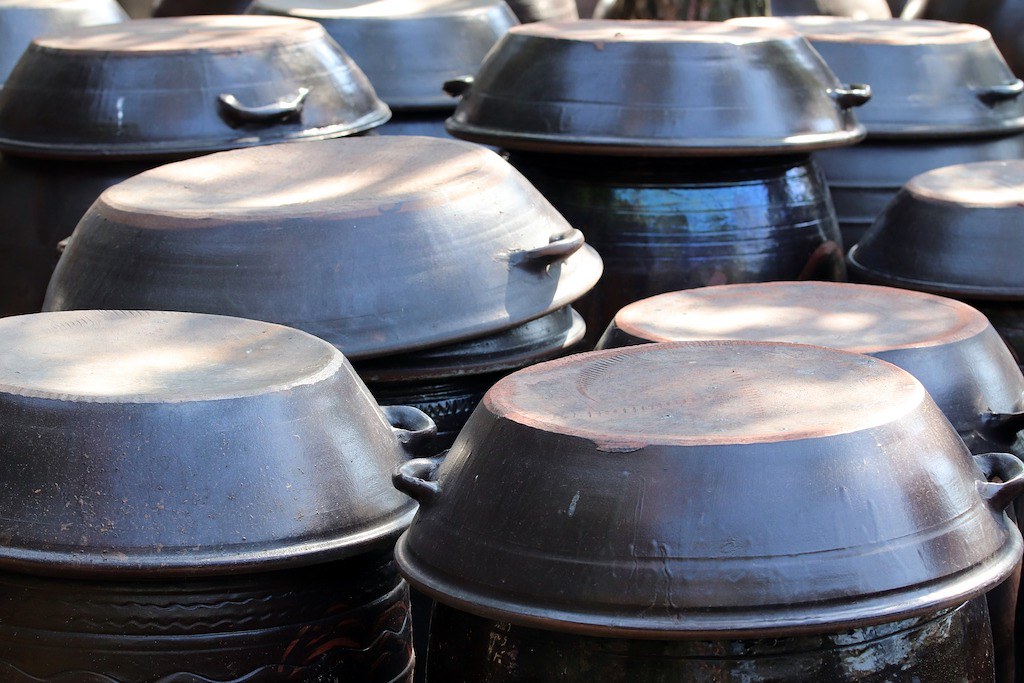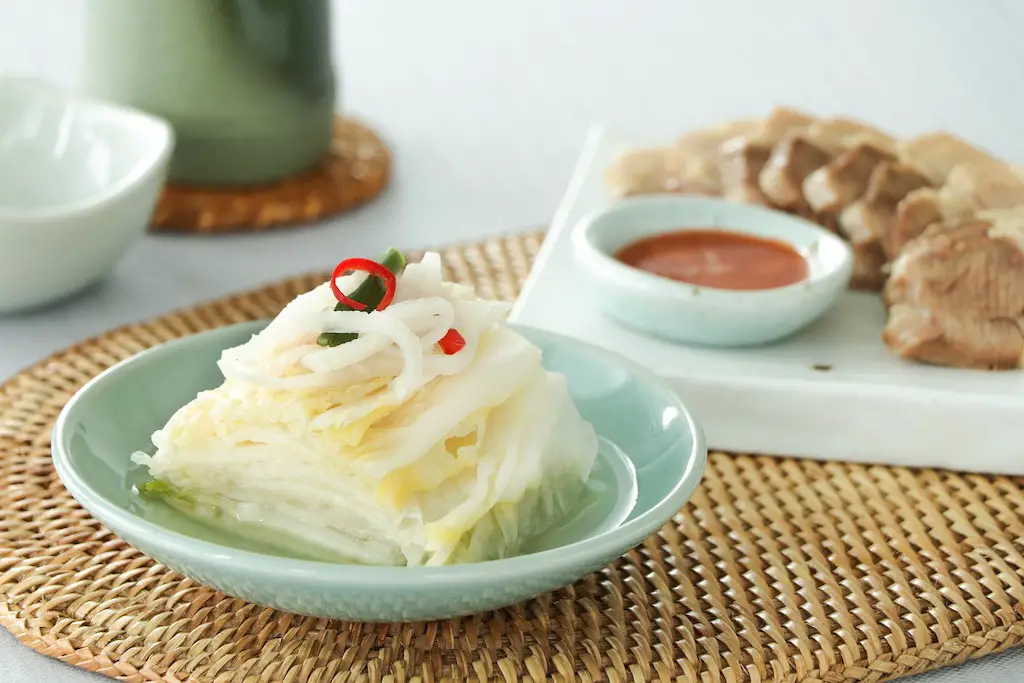This post may contain affiliate links. Please read my disclosure for details at the bottom of this page. As an Amazon Associate, I earn from qualifying purchases on this post about kimchi containers and how to store kimchi. We hope this helps you find the right kimchi container for you!
Every fall, families across South Korea come together to make their national dish: kimchi. The process is labor-intensive. It involves preparing and fermenting enough vegetables to last an entire year. To make the most famous type of Korean kimchi, known as baechu kimchi, you start by first salting napa cabbage. Then, you let the cabbage sit in a bowl as the salt absorbs into the cabbage and excretes excess water. Eventually, you wash the salt off and finally rub a gochugaru-based sauce in between every leaf of cabbage. Usually, families take an entire day to make enough kimchi for the extended family to consume throughout the year. Once made, people divide the kimchi into different containers to take home and store.
I recently wrote about kimchi refrigerators and why people use them in South Korea. Now, I want to go over different types of kimchi containers people use. After all, once you make the kimchi, you need to be able to store it properly!
People use different types of storage containers depending on their preferences, kimchi-making processes, and needs. Like most items, these different containers each have pros and cons. Here, I will list some types of kimchi containers you can find outside of Korea.
You split the types of modern kimchi containers into two different categories: plastic and glass. I hope it helps you decide which will work best for you when making kimchi!
How to Store Kimchi Traditionally:
Traditionally, before the modern inventions of kimchi containers and refrigerators, people stored their fermenting vegetables in a pot known as an onggi.
The onggi (옹기) is a type of traditionally made earthenware pot (also known as an earthenware crock) used to store and preserve different types of foods. Such foods include kimchi, gochujang (fermented red pepper paste), doenjang (fermented soybean paste), ganjang (Korean soy sauce), and more.

Korean Onggi: What Do They Contain?
In the past, people made kimchi as a family when the vegetables ripen and the weather grows cold. Then, they would place the kimchi in the earthenware ‘onggi’ pot and bury it in the ground. As the weather outside fluctuates throughout the seasons, the earth surrounding the pot would maintain the cold temperatures and humidity levels needed to preserve and ferment the kimchi. Kimchi refrigerators were developed to mimic what the ground and earth did naturally.
Now that we learned about the traditional way of keeping kimchi, let’s learn about modern storage solutions for kimchi containers!
Kimchi Container: Plastic
Below, we list some plastic-based kimchi containers. Always remember, no matter which option you pick, check the materials used to make the product. We only list products that are considered ‘food safe,’ meaning they do not contain any toxic materials, BPA, or lead.
Kimchi Container by E-Jen:

To many people, the kimchi containers made by E-Jen are the best available on the market. These containers are made specifically to store kimchi in the refrigerator.
E-Jen’s storage container is made from high-quality polypropylene plastic—a type of material ideal for making the perfect climate for fermentation. For those interested in other types of food fermentation, such as sauerkraut, you can use this container as well! Further, the polypropylene plastic prevents the strong kimchi smells from penetrating other foods in your refrigerator.
Not only does it help create the best conditions to promote fermentation, but it is also easy to use and clean! First, to use this container, you need to wash it. Then, you can place your prepared kimchi into the container and fit the adjustable plate lid tightly over top to remove the excess presence of air that may affect the fermentation process. Finally, once you eat all the kimchi, you just need to wash out the container and you can use it again!
These containers are square or rectangular so they are easy to store in the refrigerator.
Pros:
- Are made specifically for kimchi.
- These containers are easy to use and clean.
- Dishwasher, freezer, and microwave safe.
- The container does not retain odors. Further, they do not let the odors penetrate out of the container.
- Made from materials that do not contain BPA, lead, or any other toxins.
- Shaped as a rectangle or square so it can easily fit in the refrigerator.
Cons:
- The instructions are in Korean
Premium Kimchi Container By Crazy Korean Cooking:

Like the kimchi container made by E-Jen, I recommend the premium kimchi container by Crazy Korean Cooking for those interested in buying what people typically use in South Korea.
This kimchi container combines the traditional ways of Korean preservation with modern-day technology conveniences. This container is mostly made from high-quality plastic. The other main material is natural clay to imitate the porosity of the traditional onggi earthenware pots.
Also like the E-Jen version, this container has an inner lid that you can adjust to protect the kimchi from excess air and keep the freshness of the kimchi.
Pros:
- Made with materials that are BPA, lead, and toxin-free. The container complies with all FDA regulations and is ‘food safe.’
- Easy to clean and use.
- Uses modern technologies with traditional Korean materials and fermentation methods to imitate the long-established fermentation processes.
- Does not retain odor. Further, they do not let the odors penetrate out of the container.
- Shaped as a rectangle or square so it can easily fit in the refrigerator.
- Specifically designed for kimchi.
Cons:
- Some buyers complain that the container’s rubber lining does not seal it enough.
Kimchi Container: Glass
Often, you can buy kimchi in grocery stores across the United States stored in glass containers and jars. In the United States, we have a tradition of pickling and fermenting in glass ‘mason’ jars. While normal in the United States, people in South Korea do not tend to use glass in their households. Though that is the case, I wanted to give a glass option for those who prefer to avoid plastic.
Mason Jars

Like I stated above, people often use glass containers to preserve food through fermentation or pickling. You can use mason jars to store kimchi! Glass containers are incredibly durable— Not only do they prevent odors from escaping to the rest of your food, but you can use them over and over as long as you get reusable lids or buy new lids.
When picking out your jars, look for types that have a wide opening. That way, you can easily place your kimchi into the container. I also recommend using jars with hard plastic lids instead of metal when making kimchi. This prevents corroding and allows you to open the containers to remove gases building during the fermentation process.
In the end, you can pick any glass sealable jar to store your kimchi!
Pros:
- Free from BPA, lead, and toxins.
- Made from glass.
- Ideal for storing many different types of foods such as kombucha, canned goods, pickled goods, and more.
Cons:
- Glass containers need to be monitored during the fermentation process so gases do not build—glass can break if not handled with care.
We Hope You Enjoyed Learning About Kimchi Containers
In the end, we hope you enjoyed learning about different types of kimchi containers. If so, let us know in the comment section below. We will continue to write about different cooking utensils and ingredients used in Korean and Southern cooking! If you would like to read more about cooking, you can find recipes on our blog.
Korean Cooking Tools Articles:
- What Is a Korean Ttukbaegi?
- What Is a Korean Dolsot?
- Ttukbaegi vs Dolsot: What Is the Difference?
- What is a Traditional Korean Onggi?
- All About Korean Chopsticks
Korean Ingredient Articles:
- Persimmon Fruit: Persimmons in Korean Cuisine
- Asian Pear: A Guide to Asian Pears in Korean Culture
- Baechu (Napa Cabbage) in Korean Cuisine
- What are Perilla Leaves (Kkaennip)?
- Dangmyeon (Sweet Potato Glass Noodles)
- Gochugaru (Korean Pepper Powder)
- Korean Soy Sauce: What Should I Buy?
- Gluten-Free Gochujang Brands
- Gluten-free Doenjang Brands
If you have any questions or comments, you can also email us at [email protected].
And, finally, we would love to hear from you through our social media as well! You can follow us at @carvingajourney on Instagram, Facebook, and Pinterest. Or, if you would like more articles like these, you can subscribe to our blog by joining our mailing list. We hope you enjoyed learning about kimchi containers! Thank you so much for stopping by!
Carving A Journey is a participant in the Amazon Services LLC Associates Program, an affiliate advertising program designed to provide a means for sites to earn advertising fees by advertising and linking to Amazon.com. Although we may earn commissions for our endorsement, recommendation, testimonial, and/or link to any products or services from this website, these opinions are my own and I fully support these products.

